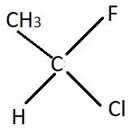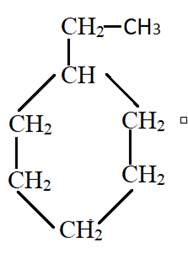
Chemistry 2012 Student Edition (hard Cover) Grade 11
12th Edition
ISBN: 9780132525763
Author: Prentice Hall
Publisher: Prentice Hall
expand_more
expand_more
format_list_bulleted
Question
Chapter 22, Problem 70A
Interpretation Introduction
Interpretation: Whether ethylcyclohexane has an asymmetric carbon atom or not needs to be explained.
Concept Introduction:
Asymmetric carbon: When carbon atom attached to four different groups.
Example:

Expert Solution & Answer
Explanation of Solution
The structure of ethylcyclohexane is as follows:

First carbon has one ethyl group, one hydrogen group and remaining two groups are same methyl group. Remaining carbon atom has two hydrogens and two methyl groups.
Hence there is no asymmetric carbon atom present in ethylcyclohexane.
Chapter 22 Solutions
Chemistry 2012 Student Edition (hard Cover) Grade 11
Ch. 22.1 - Prob. 1SPCh. 22.1 - Prob. 2SPCh. 22.1 - Prob. 3SPCh. 22.1 - Prob. 4SPCh. 22.1 - Prob. 5SPCh. 22.1 - Prob. 6SPCh. 22.1 - Prob. 7LCCh. 22.1 - Prob. 8LCCh. 22.1 - Prob. 9LCCh. 22.1 - Prob. 10LC
Ch. 22.1 - Prob. 11LCCh. 22.1 - Prob. 12LCCh. 22.1 - Prob. 13LCCh. 22.2 - Prob. 14LCCh. 22.2 - Prob. 15LCCh. 22.2 - Prob. 16LCCh. 22.2 - Prob. 17LCCh. 22.2 - Prob. 18LCCh. 22.3 - Prob. 19SPCh. 22.3 - Prob. 20SPCh. 22.3 - Prob. 21LCCh. 22.3 - Prob. 22LCCh. 22.3 - Prob. 23LCCh. 22.3 - Prob. 24LCCh. 22.3 - Prob. 25LCCh. 22.3 - Prob. 26LCCh. 22.3 - Prob. 27LCCh. 22.4 - Prob. 28LCCh. 22.4 - Prob. 29LCCh. 22.4 - Prob. 30LCCh. 22.4 - Prob. 31LCCh. 22.4 - Prob. 32LCCh. 22.5 - Prob. 33LCCh. 22.5 - Prob. 34LCCh. 22.5 - Prob. 35LCCh. 22.5 - Prob. 36LCCh. 22.5 - Prob. 37LCCh. 22.5 - Prob. 38LCCh. 22.5 - Prob. 39LCCh. 22.5 - Prob. 40LCCh. 22 - Prob. 41ACh. 22 - Prob. 42ACh. 22 - Prob. 43ACh. 22 - Prob. 44ACh. 22 - Prob. 45ACh. 22 - Prob. 46ACh. 22 - Prob. 47ACh. 22 - Prob. 48ACh. 22 - Prob. 49ACh. 22 - Prob. 50ACh. 22 - Prob. 51ACh. 22 - Prob. 52ACh. 22 - Prob. 53ACh. 22 - Prob. 54ACh. 22 - Prob. 55ACh. 22 - Prob. 56ACh. 22 - Prob. 57ACh. 22 - Prob. 58ACh. 22 - Prob. 59ACh. 22 - Prob. 60ACh. 22 - Prob. 61ACh. 22 - Prob. 62ACh. 22 - Prob. 63ACh. 22 - Prob. 64ACh. 22 - Prob. 65ACh. 22 - Prob. 66ACh. 22 - Prob. 67ACh. 22 - Prob. 68ACh. 22 - Prob. 69ACh. 22 - Prob. 70ACh. 22 - Prob. 71ACh. 22 - Prob. 72ACh. 22 - Prob. 73ACh. 22 - Prob. 74ACh. 22 - Prob. 75ACh. 22 - Prob. 76ACh. 22 - Prob. 77ACh. 22 - Prob. 78ACh. 22 - Prob. 79ACh. 22 - Prob. 80ACh. 22 - Prob. 81ACh. 22 - Prob. 82ACh. 22 - Prob. 84ACh. 22 - Prob. 85ACh. 22 - Prob. 86ACh. 22 - Prob. 87ACh. 22 - Prob. 89ACh. 22 - Prob. 90ACh. 22 - Prob. 91ACh. 22 - Prob. 92ACh. 22 - Prob. 93ACh. 22 - Prob. 94ACh. 22 - Prob. 95ACh. 22 - Prob. 96ACh. 22 - Prob. 97ACh. 22 - Prob. 98ACh. 22 - Prob. 99ACh. 22 - Prob. 100ACh. 22 - Prob. 101ACh. 22 - Prob. 102ACh. 22 - Prob. 103ACh. 22 - Prob. 104ACh. 22 - Prob. 105ACh. 22 - Prob. 106ACh. 22 - Prob. 107ACh. 22 - Prob. 108ACh. 22 - Prob. 109ACh. 22 - Prob. 110ACh. 22 - Prob. 111ACh. 22 - Prob. 1STPCh. 22 - Prob. 2STPCh. 22 - Prob. 3STPCh. 22 - Prob. 4STPCh. 22 - Prob. 5STPCh. 22 - Prob. 6STPCh. 22 - Prob. 7STPCh. 22 - Prob. 8STPCh. 22 - Prob. 9STPCh. 22 - Prob. 10STPCh. 22 - Prob. 11STPCh. 22 - Prob. 12STPCh. 22 - Prob. 13STPCh. 22 - Prob. 14STPCh. 22 - Prob. 15STPCh. 22 - Prob. 16STP
Knowledge Booster
Similar questions
- You are trying to decide if there is a single reagent you can add that will make the following synthesis possible without any other major side products: xi 1. ☑ 2. H₂O хе i Draw the missing reagent X you think will make this synthesis work in the drawing area below. If there is no reagent that will make your desired product in good yield or without complications, just check the box under the drawing area and leave it blank. Click and drag to start drawing a structure. There is no reagent that will make this synthesis work without complications. : ☐ S ☐arrow_forwardPredict the major products of this organic reaction: H OH 1. LiAlH4 2. H₂O ? Note: be sure you use dash and wedge bonds when necessary, for example to distinguish between major products with different stereochemistry. Click and drag to start drawing a structure. G C टेarrow_forwardFor each reaction below, decide if the first stable organic product that forms in solution will create a new C-C bond, and check the appropriate box. Next, for each reaction to which you answered "Yes" to in the table, draw this product in the drawing area below. Note for advanced students: for this problem, don't worry if you think this product will continue to react under the current conditions - just focus on the first stable product you expect to form in solution. NH2 CI MgCl ? Will the first product that forms in this reaction create a new CC bond? Yes No MgBr ? Will the first product that forms in this reaction create a new CC bond? Yes No G टेarrow_forward
- For each reaction below, decide if the first stable organic product that forms in solution will create a new CC bond, and check the appropriate box. Next, for each reaction to which you answered "Yes" to in the table, draw this product in the drawing area below. Note for advanced students: for this problem, don't worry if you think this product will continue to react under the current conditions - just focus on the first stable product you expect to form in solution. དྲ。 ✗MgBr ? O CI Will the first product that forms in this reaction create a new C-C bond? Yes No • ? Will the first product that forms in this reaction create a new CC bond? Yes No × : ☐ Xarrow_forwardPredict the major products of this organic reaction: OH NaBH4 H ? CH3OH Note: be sure you use dash and wedge bonds when necessary, for example to distinguish between major products with different stereochemistry. Click and drag to start drawing a structure. ☐ : Sarrow_forwardPredict the major products of this organic reaction: 1. LIAIHA 2. H₂O ? Note: be sure you use dash and wedge bonds when necessary, for example to distinguish between major products with different stereochemistry. Click and drag to start drawing a structure. X : ☐arrow_forward
- For each reaction below, decide if the first stable organic product that forms in solution will create a new C - C bond, and check the appropriate box. Next, for each reaction to which you answered "Yes" to in the table, draw this product in the drawing area below. Note for advanced students: for this problem, don't worry if you think this product will continue to react under the current conditions - just focus on the first stable product you expect to form in solution. NH2 tu ? ? OH Will the first product that forms in this reaction create a new CC bond? Yes No Will the first product that forms in this reaction create a new CC bond? Yes No C $ ©arrow_forwardAs the lead product manager at OrganometALEKS Industries, you are trying to decide if the following reaction will make a molecule with a new C-C bond as its major product: 1. MgCl ? 2. H₂O* If this reaction will work, draw the major organic product or products you would expect in the drawing area below. If there's more than one major product, you can draw them in any arrangement you like. Be sure you use wedge and dash bonds if necessary, for example to distinguish between major products with different stereochemistry. If the major products of this reaction won't have a new CC bond, just check the box under the drawing area and leave it blank. Click and drag to start drawing a structure. This reaction will not make a product with a new CC bond. G marrow_forwardIncluding activity coefficients, find [Hg22+] in saturated Hg2Br2 in 0.00100 M NH4 Ksp Hg2Br2 = 5.6×10-23.arrow_forward
- give example for the following(by equation) a. Converting a water insoluble compound to a soluble one. b. Diazotization reaction form diazonium salt c. coupling reaction of a diazonium salt d. indacator properties of MO e. Diazotization ( diazonium salt of bromobenzene)arrow_forward2-Propanone and ethyllithium are mixed and subsequently acid hydrolyzed. Draw and name the structures of the products.arrow_forward(Methanesulfinyl)methane is reacted with NaH, and then with acetophenone. Draw and name the structures of the products.arrow_forward
arrow_back_ios
SEE MORE QUESTIONS
arrow_forward_ios
Recommended textbooks for you
 ChemistryChemistryISBN:9781305957404Author:Steven S. Zumdahl, Susan A. Zumdahl, Donald J. DeCostePublisher:Cengage Learning
ChemistryChemistryISBN:9781305957404Author:Steven S. Zumdahl, Susan A. Zumdahl, Donald J. DeCostePublisher:Cengage Learning ChemistryChemistryISBN:9781259911156Author:Raymond Chang Dr., Jason Overby ProfessorPublisher:McGraw-Hill Education
ChemistryChemistryISBN:9781259911156Author:Raymond Chang Dr., Jason Overby ProfessorPublisher:McGraw-Hill Education Principles of Instrumental AnalysisChemistryISBN:9781305577213Author:Douglas A. Skoog, F. James Holler, Stanley R. CrouchPublisher:Cengage Learning
Principles of Instrumental AnalysisChemistryISBN:9781305577213Author:Douglas A. Skoog, F. James Holler, Stanley R. CrouchPublisher:Cengage Learning Organic ChemistryChemistryISBN:9780078021558Author:Janice Gorzynski Smith Dr.Publisher:McGraw-Hill Education
Organic ChemistryChemistryISBN:9780078021558Author:Janice Gorzynski Smith Dr.Publisher:McGraw-Hill Education Chemistry: Principles and ReactionsChemistryISBN:9781305079373Author:William L. Masterton, Cecile N. HurleyPublisher:Cengage Learning
Chemistry: Principles and ReactionsChemistryISBN:9781305079373Author:William L. Masterton, Cecile N. HurleyPublisher:Cengage Learning Elementary Principles of Chemical Processes, Bind...ChemistryISBN:9781118431221Author:Richard M. Felder, Ronald W. Rousseau, Lisa G. BullardPublisher:WILEY
Elementary Principles of Chemical Processes, Bind...ChemistryISBN:9781118431221Author:Richard M. Felder, Ronald W. Rousseau, Lisa G. BullardPublisher:WILEY

Chemistry
Chemistry
ISBN:9781305957404
Author:Steven S. Zumdahl, Susan A. Zumdahl, Donald J. DeCoste
Publisher:Cengage Learning

Chemistry
Chemistry
ISBN:9781259911156
Author:Raymond Chang Dr., Jason Overby Professor
Publisher:McGraw-Hill Education

Principles of Instrumental Analysis
Chemistry
ISBN:9781305577213
Author:Douglas A. Skoog, F. James Holler, Stanley R. Crouch
Publisher:Cengage Learning

Organic Chemistry
Chemistry
ISBN:9780078021558
Author:Janice Gorzynski Smith Dr.
Publisher:McGraw-Hill Education

Chemistry: Principles and Reactions
Chemistry
ISBN:9781305079373
Author:William L. Masterton, Cecile N. Hurley
Publisher:Cengage Learning

Elementary Principles of Chemical Processes, Bind...
Chemistry
ISBN:9781118431221
Author:Richard M. Felder, Ronald W. Rousseau, Lisa G. Bullard
Publisher:WILEY